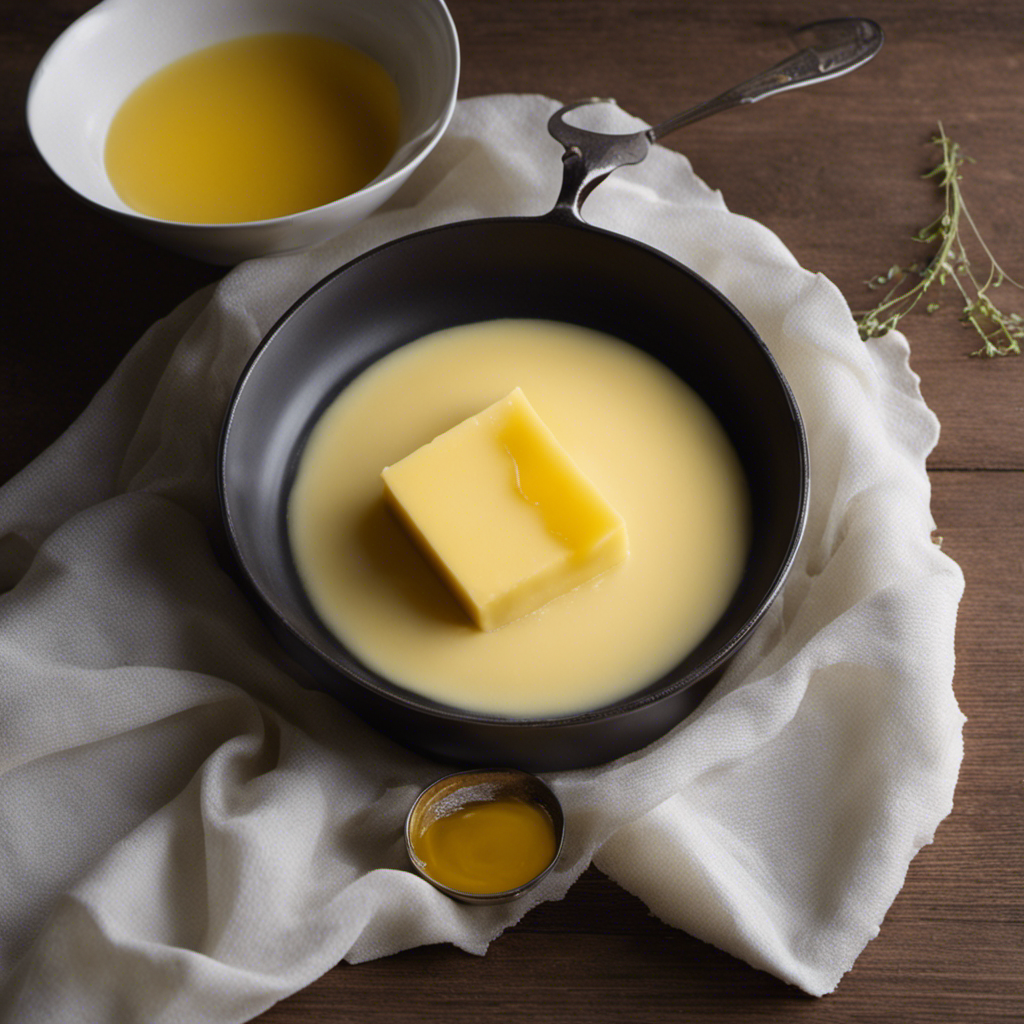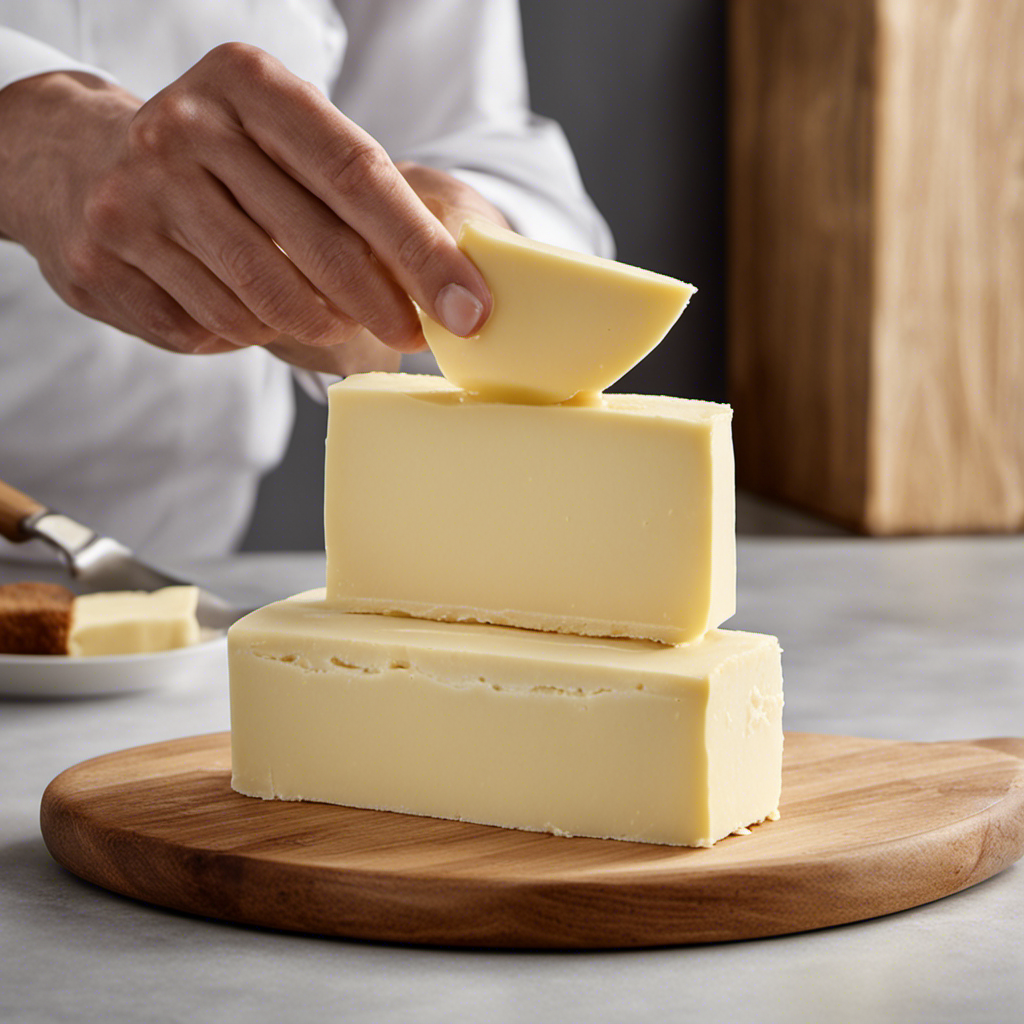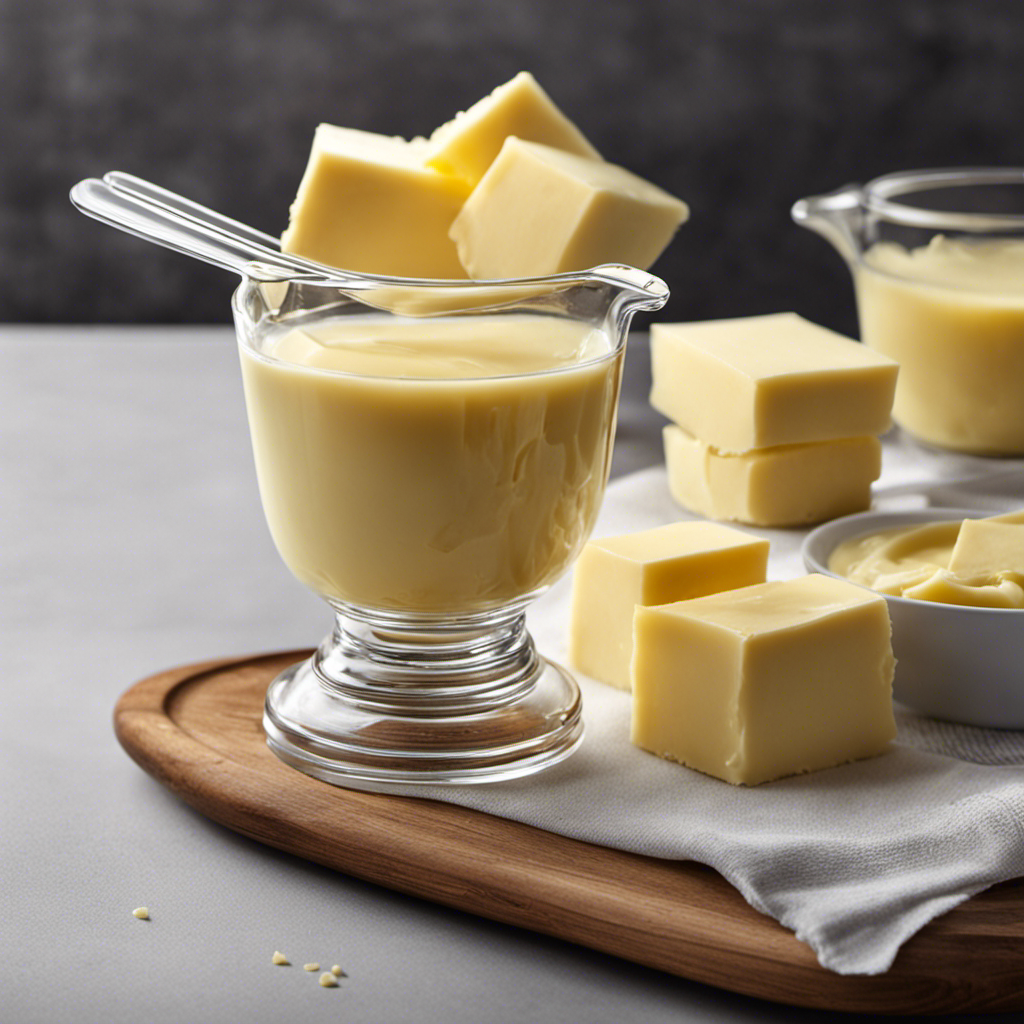Have you ever been aware that clarified butter has been utilized for generations in culinary practices? It is a flexible component that enhances the taste and richness of a diverse range of meals.
In this article, I’ll guide you through the process of making clarified butter step by step. We’ll gather the ingredients, prepare the butter, melt it down, skim off the impurities, and strain it to achieve that beautiful golden liquid.
Plus, I’ll share some health benefits and variations you can try.
Let’s get started!
Key Takeaways
- Skimming the butter and melting it are the initial steps in the process of making clarified butter.
- Straining the butter is an important step to remove impurities.
- There are different techniques for straining, including using a fine mesh strainer, cheesecloth, or coffee filter.
- Clarified butter can be stored properly for a longer shelf life and can be preserved using canning techniques.
Gathering the Ingredients
Now that you’ve got your butter, it’s time to gather the rest of the ingredients. To make clarified butter, you will need a saucepan, a fine-mesh strainer, and a clean container for storing the finished product.
The most important step in the process of making clarified butter is skimming. Skimming is crucial because it removes impurities such as milk solids and water from the butter, resulting in a clear, golden liquid.
To skim, simply melt the butter in the saucepan over low heat until it completely melts. As it melts, you will notice a foam forming on the surface. Use a spoon or a ladle to carefully remove this foam, ensuring that you don’t disturb the bottom layer of clear, clarified butter.
Skimming is essential to achieve the desired purity and smoothness of clarified butter.
Preparing the Butter
Now that we’ve gathered our ingredients and we’re ready to make clarified butter, let’s move on to preparing the butter.
One important step in this process is removing the milk solids from the butter. To do this, we’ll need to go through a straining process to ensure that our clarified butter is smooth and free of any impurities.
Removing Milk Solids
To remove the milk solids from the clarified butter, you’ll need to strain it through a fine mesh sieve. This is an essential step in the process of making clarified butter, as it ensures that the final product is smooth and free from any impurities.
Straining the butter separates the liquid golden butterfat from the solids, which tend to burn easily and can affect the flavor and texture of the clarified butter. By using a fine mesh sieve, you can effectively remove these milk solids, leaving you with a pure and clear liquid.
Once strained, the clarified butter is ready to be used in cooking or storing for later use. Now that we have removed the milk solids, let’s move on to the next step of the straining process.
Straining Process
Once you’ve strained the mixture through a fine mesh sieve, you’ll have a smooth and impurity-free liquid. Straining is a crucial step in the process of making clarified butter, as it helps remove any remaining milk solids or impurities.
To ensure a thorough straining, it is important to use the right straining equipment. A fine mesh sieve is ideal for this task, as it effectively catches any small particles while allowing the liquid to pass through. Another useful tool is cheesecloth, which can be placed over the sieve for an even finer straining.
Melting the Butter
First, you’ll want to place the butter in a small saucepan and start melting it over low heat. This melting technique is crucial for achieving clarified butter. Here’s how to do it:
- Cut the butter into small, uniform pieces. This will help it melt evenly.
- Keep an eye on the butter temperature. You want it to melt slowly and gently, so the heat should be low. This prevents the milk solids from burning and helps separate them from the butterfat.
- Stir occasionally to ensure even melting. This also helps distribute the heat and prevents the butter from sticking to the bottom of the pan.
Once the butter has completely melted, you can move on to the next step: skimming the impurities. This process removes any remaining milk solids and ensures that you have pure, clarified butter.
Skimming the Impurities
Skimming is an essential step in the process of making clarified butter. It is important because it helps remove impurities and solids from the melted butter, resulting in a smoother and purer final product.
To skim effectively, there are a few techniques and tips to keep in mind. One technique is using a spoon to carefully remove the foam that rises to the surface. This foam consists of impurities and solids that you want to get rid of. By skimming off this foam, you are ensuring that your clarified butter is clear and free from any unwanted particles.
Another tip is to repeat the skimming process as needed until the butter is clear. Sometimes, you may need to skim multiple times to achieve the desired level of clarity. It’s important to be patient and thorough during this step to ensure the best results.
Importance of Skimming
To make clarified butter, it’s important to remove the milk solids by skimming them off the surface. Skimming has several benefits, including improved flavor, increased shelf life, and enhanced cooking properties.
Improved flavor: By removing the milk solids, you eliminate any potential burnt or bitter taste that they may impart to the butter. This results in a smoother, more delicate flavor.
Increased shelf life: Skimming not only removes impurities but also water content. This makes clarified butter less prone to spoilage, allowing it to be stored for longer periods without refrigeration.
Enhanced cooking properties: The absence of milk solids in clarified butter means it has a higher smoke point, making it ideal for high-temperature cooking methods like sautéing and frying.
To skim the milk solids effectively, follow these techniques:
-
Allow the butter to melt slowly over low heat, without stirring, to encourage the milk solids to separate.
-
Once the butter has melted, gently skim off the foam and milk solids that rise to the surface using a spoon or ladle.
-
Continue skimming until no more solids are visible, ensuring a pure and clarified final product.
Skimming Techniques and Tips
When melting the butter slowly over low heat, it’s important to allow the milk solids to separate before skimming them off.
Skimming the butter has several benefits. Firstly, it removes impurities such as milk solids, water, and impurities, which can affect the taste and shelf life of the clarified butter. Skimming also helps to achieve a clearer and smoother texture, making it ideal for cooking and baking purposes.
To achieve the best results, use a fine mesh skimmer or a spoon to carefully remove the solids from the surface of the melted butter. Take your time to skim off as much as possible, ensuring that only the pure, golden liquid remains.
Once the skimming process is complete, it’s time to move on to straining the butter, which will further purify it.
Straining the Butter
Once the butter has melted, you’ll need to strain it to remove any impurities. This step is crucial in the clarifying process, as it ensures that your clarified butter is smooth and free from any unwanted particles. Here are three skimming techniques to help you achieve perfectly strained clarified butter:
-
Using a fine mesh strainer: Place the strainer over a heatproof container and carefully pour the melted butter through it. The fine mesh will catch any small impurities, leaving you with a clear liquid.
-
Cheesecloth method: Line a strainer with a double layer of cheesecloth and set it over a bowl. Gently pour the melted butter into the lined strainer, allowing it to slowly strain through the cheesecloth, capturing any solids.
-
Coffee filter method: Place a coffee filter in a strainer or funnel and set it over a jar or container. Slowly pour the melted butter through the filter, allowing it to strain slowly and effectively.
Clarifying Process
For a smooth and pure end result, strain the melted butter using one of these skimming techniques. Removing impurities is an essential step in the clarifying process, ensuring that the final product is of the highest quality.
When straining clarified butter, I recommend using a fine-mesh sieve or cheesecloth to catch any remaining solids or impurities. This will help preserve the freshness and taste of the butter. Gently pour the melted butter through the sieve or cheesecloth, allowing the liquid to separate from any unwanted particles.
The strained clarified butter will be clear, golden, and free from any impurities, ready to be used in a variety of culinary applications. By removing impurities and preserving freshness, you can achieve a clarified butter that is both visually appealing and flavorful.
Storing and Preserving
When it comes to storing and preserving food, it is crucial to follow proper storage methods, adhere to shelf life guidelines, and minimize spoilage risks.
Proper storage methods include using airtight containers, keeping food in the appropriate temperature range, and avoiding cross-contamination.
Understanding shelf life guidelines helps us determine how long different types of food can be safely stored.
Preventing spoilage risks involves practicing good hygiene, regularly inspecting and discarding expired items, and rotating food stock to ensure freshness.
Proper Storage Methods
To properly store your clarified butter, make sure you refrigerate it in an airtight container. This will help maintain its freshness and prevent it from spoiling. Here are some proper storage techniques to ensure your clarified butter stays in its best condition:
-
Choose the right container: Use a glass or plastic container with a tight-fitting lid. This will help keep out air and moisture, which can cause the butter to spoil.
-
Keep it cool: Store your clarified butter in the refrigerator, as it is sensitive to heat. This will help extend its shelf life and prevent it from becoming rancid.
-
Label and date: Always label your container with the date of preparation. This will help you keep track of its freshness and ensure you use it within a reasonable timeframe.
Shelf Life Guidelines
Now that we know how to properly store clarified butter, let’s discuss its shelf life and the various methods to preserve it.
Clarified butter has a relatively long shelf life compared to regular butter due to the removal of water and milk solids. When stored in an airtight container in the refrigerator, it can last for up to six months. However, if you want to extend its shelf life even further, you can freeze it for up to a year. Freezing is a great option if you have made a large batch and want to ensure it stays fresh for longer.
Additionally, you can use canning techniques such as sterilizing jars and sealing them tightly to preserve clarified butter at room temperature. By following these preserving methods, you can enjoy the rich flavor of clarified butter for an extended period.
Now, let’s move on to the next section where we will discuss preventing spoilage risks.
Preventing Spoilage Risks
To prevent spoilage risks, you should ensure that your storage container is clean and airtight. Here are three key practices to follow for preventing spoilage and extending the shelf life of your food:
-
Properly clean your storage container: Before storing any food, make sure to thoroughly clean the container with warm soapy water. This will help remove any bacteria or residue that could cause spoilage.
-
Use airtight containers: Air is the enemy when it comes to food spoilage. By using airtight containers, you can prevent oxygen from reaching the food, slowing down the spoilage process and extending its shelf life.
-
Store food at the right temperature: Different foods require different storage temperatures. Properly refrigerating or freezing your food can help prevent spoilage and keep it fresh for longer.
Flavoring Options
You can add various herbs and spices to infuse the clarified butter with different flavors. This not only adds a burst of taste to your dishes but also enhances the health benefits of the butter.
Some popular flavoring options include garlic, rosemary, turmeric, and cinnamon. Garlic not only imparts a delicious taste but also offers numerous health benefits, such as boosting the immune system and reducing blood pressure.
Rosemary adds a savory, herby flavor and is known for its antioxidant properties. Turmeric, with its earthy taste, is well-known for its anti-inflammatory and anti-cancer properties.
Lastly, cinnamon adds a warm, sweet flavor and is believed to help regulate blood sugar levels.
Cooking With Clarified Butter
Cooking with clarified butter can enhance the flavors of your dishes and provide a healthier alternative to other cooking oils. Here are three ways you can use clarified butter to elevate your cooking:
-
Sautéing and Stir-Frying: Clarified butter has a high smoke point, making it ideal for high-heat cooking techniques like sautéing and stir-frying. It adds a rich, nutty flavor to vegetables, meats, and seafood, while also ensuring that they cook evenly and develop a delicious caramelized crust.
-
Baking: Replace regular butter or oil with clarified butter in your favorite baking recipes for a lighter, yet still buttery flavor. It adds moisture and tenderness to cakes, cookies, and pastries, while also giving them a beautiful golden color.
-
Finishing Touch: Drizzle a little clarified butter over roasted vegetables, steamed seafood, or grilled meats before serving. It adds a luxurious, velvety finish to your dishes, enhancing their overall taste and presentation.
With these cooking techniques and recipe variations, clarified butter can take your culinary creations to the next level. Give it a try and experience the difference yourself!
Health Benefits
Using clarified butter in your recipes can provide various health benefits. Clarified butter is a great option for those looking to maintain or lose weight. It contains healthy fats that can keep you feeling fuller for longer, reducing the need for snacking between meals. Additionally, clarified butter is low in lactose and casein, making it suitable for individuals with lactose intolerance or dairy allergies.
When it comes to cholesterol levels, clarified butter is a better choice compared to regular butter. The process of clarifying removes milk solids and water, leaving behind pure butterfat. This results in a product that is lower in cholesterol and saturated fat. By replacing regular butter with clarified butter in your cooking, you can help improve your overall cholesterol profile and reduce the risk of heart disease.
Butter Variations
When it comes to different types of butter, it’s important to consider the various variations available in the market. Here are three popular butter flavorings you can find:
-
Garlic Butter: This savory option is perfect for adding a burst of flavor to dishes like garlic bread, pasta, or grilled vegetables. Its rich garlic taste adds depth to any recipe.
-
Honey Butter: For those with a sweet tooth, honey butter is a delightful choice. Spread it on toast, pancakes, or waffles for a deliciously sweet and creamy treat.
-
Herb Butter: Herb butter is a versatile option that can be used in a variety of dishes. Whether you’re roasting chicken, grilling steak, or simply spreading it on bread, the combination of herbs and butter creates a flavorful experience.
In addition to these variations, another popular option is clarified butter. Clarified butter is butter that has been melted and the milk solids removed, resulting in a pure, golden liquid. It has a higher smoke point than regular butter, making it ideal for frying and sautéing. It also has a longer shelf life and a rich, nutty flavor that adds a delicious touch to both sweet and savory dishes.
Whether you’re looking for unique butter flavors or a versatile cooking ingredient, there are plenty of options to explore.
Troubleshooting Tips
If your butter is not spreading easily, try microwaving it for a few seconds to soften it up.
When making clarified butter, there are a few common mistakes that can occur. One of these is not removing all the milk solids, which can lead to a cloudy appearance and a lower smoke point. To avoid this, make sure to skim off the foam that forms on top during the clarifying process.
Another mistake is overheating the butter, which can result in a burnt flavor. It’s important to melt the butter slowly over low heat, stirring occasionally to prevent any scorching.
Additionally, using unsalted butter is recommended to have more control over the salt content in the final product.
Frequently Asked Questions
Can I Use Any Type of Butter for Making Clarified Butter?
Yes, you can use any type of butter for making clarified butter. However, it is recommended to use unsalted butter as it produces a cleaner flavor. Margarine or ghee can also be used as substitutes.
How Long Does It Take to Clarify Butter?
Clarifying butter time varies based on the quantity, but generally takes around 20-30 minutes. The process involves melting butter, skimming off the foam, and straining the clarified liquid.
Can I Reuse the Impurities That I Skim off From the Butter?
Sure, you can reuse the impurities skimmed off from the butter, but it’s not recommended. They contain milk solids and water, which can affect the taste and texture of your dishes. There are better alternative uses for them.
Will Clarified Butter Have a Different Taste Compared to Regular Butter?
Clarified butter does have a different taste compared to regular butter. It has a rich, nutty flavor and a higher smoke point. It is similar to ghee, which is also clarified butter but cooked longer for a more intense flavor.
Can I Clarify Butter in the Microwave?
Yes, you can clarify butter in the microwave. It’s a quicker method than stovetop clarification. The benefits of clarified butter include a higher smoke point and longer shelf life. But be careful not to overheat it!
Conclusion
In conclusion, making clarified butter is a simple yet rewarding process. By gathering the necessary ingredients and following the steps carefully, you can create a golden elixir that enhances the flavors of your dishes.
This liquid gold, with its pure and silky texture, is like a ray of sunshine melting into your food, enriching it with a deep, nutty aroma.
So go ahead and try your hand at making clarified butter, and let your culinary creations shine with its delicious touch.









